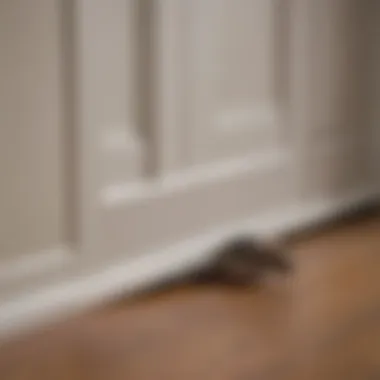Ultimate Guide to Rodent-Proof Door Sweeps: Prevention Tips and Installation Insights


Preventive Pest Control Strategies
When it comes to ensuring a pest-free environment in your home, preventive pest control strategies play a crucial role. Starting with protecting the house exterior, sealing cracks and crevices is essential to prevent pests from finding their way inside. Clearing away debris from the surroundings not only enhances the aesthetics but also minimizes potential hiding spots for pests. Securing entry points and installing rodent-proof door sweeps are effective measures in keeping rodents at bay. Moving on to yard maintenance, regular care routines such as mowing the lawn, trimming bushes, and removing standing water prevent common yard pests from flourishing. Indoor cleanliness is equally important; expert cleaning tips involve decluttering regularly, wiping down surfaces, and proper waste management to eliminate attractants for pests. Efficient garbage disposal methods should be practiced to avoid creating a feeding ground for pests. Explore innovative ways to safeguard your home beyond the conventional methods for comprehensive pest prevention.
Identifying Pest Risk Areas
To effectively combat pest infestations, it's crucial to identify potential risk areas in and around your home. Conducting inspections in moisture-prone areas allows you to spot damp conditions that are favorable for pests like termites and cockroaches. Sealing cracks and crevices with the appropriate materials serves as a barrier against pest intrusion. Inspecting greenery for pest risks sheds light on how plants can attract pests and offers guidelines on maintaining a pest-resistant yard. Additionally, pay attention to miscellaneous risk areas such as attics, basements, and crawl spaces that pests may utilize as entry points. Implementing preventive measures in these areas enhances your overall pest control efforts.
Effective Pest Control Methods
When preventive measures alone are not sufficient, incorporating effective pest control methods becomes necessary. Utilizing natural repellents such as essential oils, herbs, and plants can deter pests without harming the environment or occupants. Chemical sprays, when handled safely and responsibly, provide targeted pest eradication for more severe infestations. Employing pest traps offers a humane way to capture and remove pests from your surroundings. Biological control methods involve leveraging natural predators to manage pest populations in a sustainable manner. While exploring traditional and innovative pest control methods, prioritizing environmental-friendly solutions contributes to a safer living environment for all.
Pest Species Identification
Understanding the pests that pose a threat to your home is the first step towards effective pest control. Common household insects like ants, cockroaches, and spiders are often manageable with proper identification and control measures. Rodents such as mice and rats can cause significant damage if not addressed promptly, making rodent prevention crucial. Bird species impacting home environments may necessitate interventions to deter them from nesting on your property. Dealing with wildlife encounters requires knowledge of their behavior and implementing appropriate control measures. By identifying and managing various pest species, you can tailor your pest control efforts for maximum effectiveness.
DIY Pest Control Techniques
DIY pest control techniques provide homeowners with environmentally-friendly and cost-effective solutions to manage pests. Using homemade remedies like vinegar sprays and citrus peels can repel pests without the need for harsh chemicals. Essential oils with insect-repellent properties offer a natural way to keep pests at bay while creating a pleasant indoor atmosphere. Implementing pest traps and barriers, choosing reputable pest control products, and exploring unique DIY solutions tailored to your specific pest issues empower you to take control of your home's pest management effectively. By arming yourself with these techniques, you can proactively address pest concerns and maintain a pest-free living space.
Introduction
In the realm of pest control, the rodent-proof door sweep stands as a pivotal defense against unwanted intruders such as mice and rats. This comprehensive guide aims to shed light on the critical role that a door sweep plays in fortifying residential and commercial spaces against rodent infestations. By understanding the nuances of this often-overlooked aspect of home maintenance, individuals can proactively safeguard their properties and ensure a hygienic living environment. To grasp the full spectrum of benefits and considerations surrounding rodent-proof door sweeps, delve into the following sections.
Understanding the Importance of Rodent-Proof Door Sweeps
Rodents as Common Household Pests
The plight of dealing with rodents as persistent household pests is a reality that many homeowners face. Rodents such as mice and rats possess a remarkable ability to infiltrate even the smallest crevices, making traditional methods of pest control ineffective. This is where the significance of employing a rodent-proof door sweep becomes apparent. By choosing the appropriate door sweep material and installation method, individuals can effectively block rodents' access points, thereby fortifying their homes against infestations.


These rodents are characterized by their tenacity and ability to reproduce rapidly, posing a continuous threat to both health and property. Through the utilization of a rodent-proof door sweep, property owners can create a formidable barrier that deters these unwelcome guests. The unique feature of rodent-proof door sweeps lies in their capacity to seal off gaps beneath doors, preventing rodents from entering living spaces. This design ensures that homes remain secure and free from the disturbances caused by rodent intrusions.
Impact of Rodent Infestations on Health and Property
The repercussions of a rodent infestation extend beyond mere inconvenience, posing genuine risks to both health and property. Rodents are notorious carriers of diseases, making their presence a potential hazard to the well-being of occupants. Moreover, their propensity for gnawing on various materials can result in significant damage to the structural integrity of buildings, leading to costly repairs.
This underscores the critical need for proactive measures such as installing rodent-proof door sweeps to mitigate the adverse effects of infestations. By acknowledging the role that these pests play in compromising health and property, individuals can appreciate the value of investing in robust pest control solutions. The door sweep serves as a first line of defense, reinforcing boundaries and preventing rodents from encroaching on indoor spaces. Embracing the preventative approach provided by rodent-proof door sweeps is not just a matter of convenience but a proactive stance towards safeguarding one's health and property.
Features to Consider
In the comprehensive guide to Rodent-Proof Door Sweeps, understanding the importance of the features to consider is crucial. When selecting a door sweep, various elements need to be taken into account to ensure its effectiveness in preventing rodent infestations.
Materials
Rubber
Rubber is a key material choice for door sweeps due to its flexibility and durability. The elasticity of rubber allows for a snug fit against the door, effectively sealing gaps that rodents could exploit. Its resilience to varying temperatures ensures longevity, making it a popular and practical option. One of the main advantages of rubber is its ability to compress, providing a tight barrier that effectively keeps rodents out. However, one drawback of rubber is its susceptibility to wear over time, especially in high-traffic areas.
Aluminum
Aluminum door sweeps offer unmatched durability and weather resistance. The lightweight yet sturdy nature of aluminum makes it an excellent choice for long-term protection against rodents. Its corrosion-resistant properties make it ideal for outdoor use, ensuring maintenance-free reliability. The rigidity of aluminum provides a solid barrier against rodents, deterring their entry effectively. While aluminum is highly durable, its rigid structure may not conform as snugly to uneven surfaces compared to more flexible materials.
Brush Seals
Brush seals are known for their exceptional sealing capabilities and durability. These seals consist of densely packed bristles that effectively block any openings that rodents could exploit. The flexibility of brush seals allows for easy adaptation to various door shapes and sizes, offering a versatile solution. The unique feature of brush seals is their ability to maintain effectiveness even in high-traffic areas, providing long-lasting rodent protection. However, brush seals may require occasional maintenance to ensure that the bristles remain intact and functional.
Size and Length
Customizable Options


Customizable options for door sweeps allow for precise fitting to different door sizes. The ability to tailor the sweep to the exact measurements of the door ensures maximum coverage, leaving no room for rodents to enter. Customizable options provide a personalized touch, catering to specific door dimensions and requirements. This feature enhances the overall effectiveness of the door sweep by eliminating gaps that rodents could exploit. However, customizations may require additional time and effort during installation.
Durability and Weather Resistance
Impact on Longevity
The impact of durability and weather resistance on the longevity of a door sweep is significant. Choosing a sweep that can withstand environmental factors and wear is crucial for long-term protection against rodents. Door sweeps with high durability and superior weather resistance offer prolonged effectiveness in rodent prevention. The longevity of the sweep is directly impacted by its ability to resist moisture, temperature fluctuations, and physical wear. Opting for a door sweep with superior durability ensures sustained protection against rodent intrusions, reducing the need for frequent replacements.
Installation Tips
In the realm of rodent-proof door sweeps, installation tips play a crucial role in ensuring the effectiveness of this pest control measure. Proper installation is key to sealing off potential entry points for rodents, providing a barrier that deters these unwelcome guests. The significance of installation tips lies in their ability to guide homeowners and businesses on the correct methods to install a door sweep securely.
Tools Needed
Tape Measure
The tape measure stands as a fundamental tool in the door sweep installation process. Its precise measurements are essential for ensuring the door sweep fits accurately, leaving no gaps for rodents to exploit. The key characteristic of a tape measure lies in its flexibility and ease of use, allowing for quick and accurate measurements. This tool is a popular choice for this article due to its indispensable role in achieving a snug fit, which is crucial for rodent prevention efforts. One unique feature of the tape measure is its retractable design, enabling users to conveniently measure various surfaces. While the tape measure is a beneficial tool, users should handle it carefully to prevent inaccurate measurements.
Screwdriver
A screwdriver is a critical component in the installation of a door sweep. Its main role involves securing the sweep in place, ensuring it remains intact and functional. The key characteristic of a screwdriver is its ability to drive screws into the door without damaging the material. This tool is a popular choice for this article because of its simplicity and effectiveness in attaching door sweeps securely. One unique feature of a screwdriver is its ergonomic handle, providing users with comfort during use. While the screwdriver is beneficial in the installation process, users should exercise caution to avoid over-tightening screws, which can lead to damage.
Drill
The drill serves as a power tool that expedites the installation of a door sweep. Its key characteristic lies in its ability to create holes for screws efficiently, saving time and effort. The drill is a popular choice for this article due to its productivity and accuracy in drilling holes for fastening the sweep. One unique feature of a drill is its variable speed settings, allowing users to control the drilling process based on the material being worked on. While the drill offers multiple advantages in the installation of door sweeps, users should practice proper drilling techniques to avoid splintering or damaging the door.
Step-by-Step Guide
Measuring and Cutting the Sweep


A crucial step in the installation process is measuring and cutting the door sweep to fit the door frame perfectly. This ensures a seamless seal that prevents rodents from entering. The key characteristic of this step lies in precision, as even a small gap can compromise the sweep's effectiveness. Utilizing the measurements taken with the tape measure, homeowners can cut the sweep to the exact size needed. One advantage of this process is the customization it offers, allowing for tailored solutions to different door sizes. However, care must be taken during cutting to avoid inaccuracies that could impact the door sweep's performance.
Attaching the Sweep to the Door
The final step in installing a door sweep is attaching it securely to the door. This involves using the screwdriver and drill to fasten the sweep in place. The key characteristic of this step is ensuring that the sweep is firmly fixed, providing a barrier that rodents cannot breach. Attaching the sweep to the door offers the advantage of long-term protection against infestations, maintaining a rodent-free environment. However, users should follow the manufacturer's instructions carefully to avoid damaging the door or the sweep during attachment.
Maintenance Practices
In the realm of rodent-proof door sweeps, maintenance practices stand as a critical component that often dictates the longevity and efficiency of the product. Regular maintenance not only ensures the proper functioning of the door sweep but also helps in preventing any potential rodent invasions. By incorporating consistent maintenance routines, individuals can effectively safeguard their residential or commercial spaces from unwanted pests.
Regular Cleaning
Proper and thorough cleaning of the rodent-proof door sweep is paramount in eliminating any traces of debris and dirt that may accumulate over time. The build-up of such particles not only compromises the aesthetic appeal of the door sweep but also hampers its ability to provide a secure barrier against rodents. Regular cleaning helps in maintaining the effectiveness of the sweep, ensuring that it continues to serve its purpose optimally.
Removing Debris and Dirt:
The task of removing debris and dirt from the door sweep is crucial in upholding its functionality. Whether it's dust, leaves, or other forms of buildup, ensuring the sweep remains clear and unobstructed is key. By diligently removing debris and dirt, individuals can prevent blockages that might impede the movement of the sweep or create entry points for rodents. This meticulous cleaning practice not only enhances the appearance of the door sweep but also contributes to its overall performance.
Inspection
Apart from regular cleaning, conducting periodic inspections on the door sweep is essential in identifying any signs of wear and tear. Inspections allow individuals to preemptively address any potential issues before they escalate, thereby prolonging the lifespan of the door sweep and maintaining its effectiveness in rodent-proofing. By incorporating inspection as part of the maintenance routine, users can ensure that their door sweeps remain in optimal condition, ready to withstand any rodent intrusion.
Checking for Wear and Tear:
The process of checking for wear and tear involves a meticulous evaluation of the door sweep for any signs of damage or degradation. From cracks in the material to loose fittings, identifying wear and tear early on is crucial in preventing any compromises in the door sweep's performance. This proactive approach enables individuals to take timely measures such as repairs or replacements, thereby safeguarding their spaces against potential rodent infestations effectively.
Conclusion
In the realm of rodent-proof door sweeps, the importance of a well-structured conclusion cannot be overstated. This final section serves as the culmination of all the detailed information provided throughout the article, highlighting key takeaways and underscoring the significance of implementing a rodent-proof door sweep in both residential and commercial settings.
One of the primary elements emphasized throughout this comprehensive guide is the crucial role that a quality door sweep plays in preventing unwanted rodent infestations. By acting as a physical barrier that seals off potential entry points, a rodent-proof door sweep acts as a vital line of defense against these pesky intruders, safeguarding the health and property of individuals within a space.
Moreover, the conclusion delves into the core benefits that come with investing in a rodent-proof door sweep. From maintaining a hygienic and safe environment to preserving the structural integrity of a building, the multifaceted advantages of such a preventive measure are manifold and cannot be overlooked. By blocking rodents' access to indoor spaces, individuals can enjoy peace of mind without the looming threat of infestations.
Furthermore, the conclusion also addresses essential considerations that readers should bear in mind when contemplating the installation of a rodent-proof door sweep. Factors such as compatibility with existing door types, durability, and weather resistance are crucial aspects that deserve careful attention to ensure optimal functionality and long-term effectiveness.
In wrapping up this comprehensive guide, the conclusion serves as a reminder of the proactive steps individuals can take to fortify their living or working environment against rodent incursions. By following the guidance provided in this article, readers are empowered with the knowledge and insights needed to make informed decisions and take action to protect their indoor spaces. Embracing the recommendations outlined here will undoubtedly contribute to a more secure, sanitary, and harmonious living or working environment free from the disruptions caused by rodent infestations.



